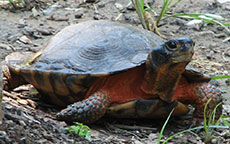What will be a three-year study of the vulnerable wood turtle kicked off in Haverhill yesterday with a review of sites along Little River.
Working with Haverhill Conservation Commissioner Ralph T. Basiliere, Zoo New England Field Biologist Julie Lisk and Field Technician Ryan Roseen scoped out a dozen sites for eventually finding specimens and tracking them. WHAV caught up with them off Newark Street. Lisk explains the tan, grayish-brown or brown-shelled turtle has been given the status of “special concern” in Massachusetts.
“Their populations are declining so we’re here to see if there are wood turtles in the stream. If so, try to get an idea of population and potentially put radios, and radio track them; find out where they’re nesting; protect nests,” she explained.

An example of a wood turtle.
The state designation of “special concern” is below the ranks of “threatened” and “endangered.” However, wood turtle population has gradually changed from being the most common freshwater turtle in eastern Massachusetts to relatively rare. Officials blame hay-mowing operations, development of wooded stream banks, roadway casualties, pet collecting, a greater number of predators, forestry and agricultural activities and pollution.
Besides fitting the five- to eight-inch turtles with tiny transmitters, the team may eventually take some turtles inside for what they call “headstarting.” That is, the turtles are sheltered for 10 months until they are large enough to better protect themselves against predators.
Roseen began with Zoo New England as an intern last fall, tracking Blanding’s turtles at Great Meadows National Wildlife Refuge. He has since taken an interest in wood turtles. “They’re just an interesting species. It’s important for us to protect them and learn more about them.”
In his role as community affairs liaison, Basiliere showed them other potential river entry sites, including Clement Farm, Rosemont Street bridge, Hilldale Cemetery, Cashman Field, Winter Street bridge, the city Highway Department property and St. James Cemetery.
“The role of the Conservation Commission here is to lend logistical support to Zoo New England and to all our public and private partners who are interested in protecting habitat,” he said.
The team was assisted on the last leg of the trip by Animal Control Officer Michelle Hamel. While they did not spot any wood turtles, they did see ducks, a hawk and a coyote.
